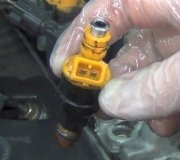The system is in anti-theft mode when it stalls after one to two seconds. A voltage spike confuses either the Body Controller or the Engine Computer into self-programming itself to think it's on a car with the factory anti-theft system. Either computer will then tell the other one (incorrectly) that it is on a car equipped with anti-theft. The second computer then does the same thing to itself. This programming can not be undone. You will have to replace both computers at the same time with units from a car that did not have anti-theft, or two rebuilt units from the dealer.
Most salvage yards don't inventory their computers according to manufacturer-installed features, only by part number. You must specify a Body Computer and Engine Computer from the same vehicle, and install both of them at the same time, before you turn on the ignition switch. If the engine runs, you're done. If it does the same thing, return them and try a pair from another car. Remember, if any one computer has anti-theft programming in it, it will teach it to the other one. From then on, those computers will only work in a car with anti-theft built in because it needs the disarm signal from the remote key fob or door switches to allow the injectors to fire.
This happened once to a Dynasty when I worked at the dealership in the 90s, and it happened to a '94 Intrepid donated to my community college by Chrysler. My stubborn tool room attendant refused to believe that both computers had to be replaced at the same time, and to save tax payer dollars, we wanted to find salvage yard parts. It took two years before we found a pair of modules without the anti-theft programming, (we weren't trying real hard), and could use the car again. We deserve part of the blame for that one because we make the students remove the battery every day after we use the car for experimentation. The sparking at the battery cables is believed to cause a lot of spikes that lead to this problem.
The advantage of this characteristic, if you can call it that, is that there don't need to be different part numbers for these computers depending on anti-theft vs. Non-anti-theft cars. You just stick it in and the self-programming will take care of itself from the other computer. Of course, if the new computer doesn't solve the problem you're working on and you take it off the car, that computer could be programmed now to the anti-theft system and could teach that to the computer on the next car it's installed on.
Caradiodoc
Saturday, August 8th, 2009 AT 3:14 AM


